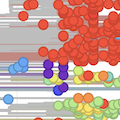Abstract
After its emergence in Wuhan, China, in late November or early December 2019, the severe acute respiratory syndrome coronavirus 2 (SARS-CoV-2) virus rapidly spread globally. Genome sequencing of SARS-CoV-2 allows the reconstruction of its transmission history, although this is contingent on sampling. We analyzed 453 SARS-CoV-2 genomes collected between 20 February and 15 March 2020 from infected patients in Washington state in the United States. We find that most SARS-CoV-2 infections sampled during this time derive from a single introduction in late January or early February 2020, which subsequently spread locally before active community surveillance was implemented.
